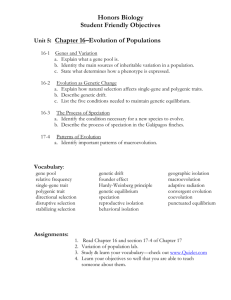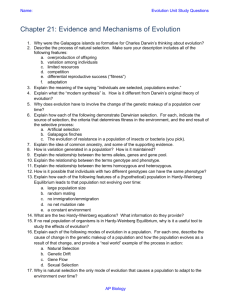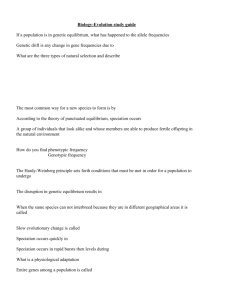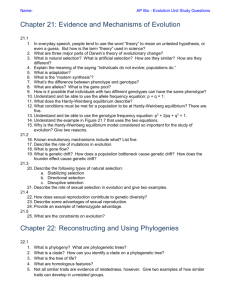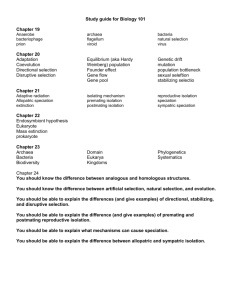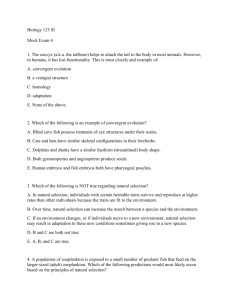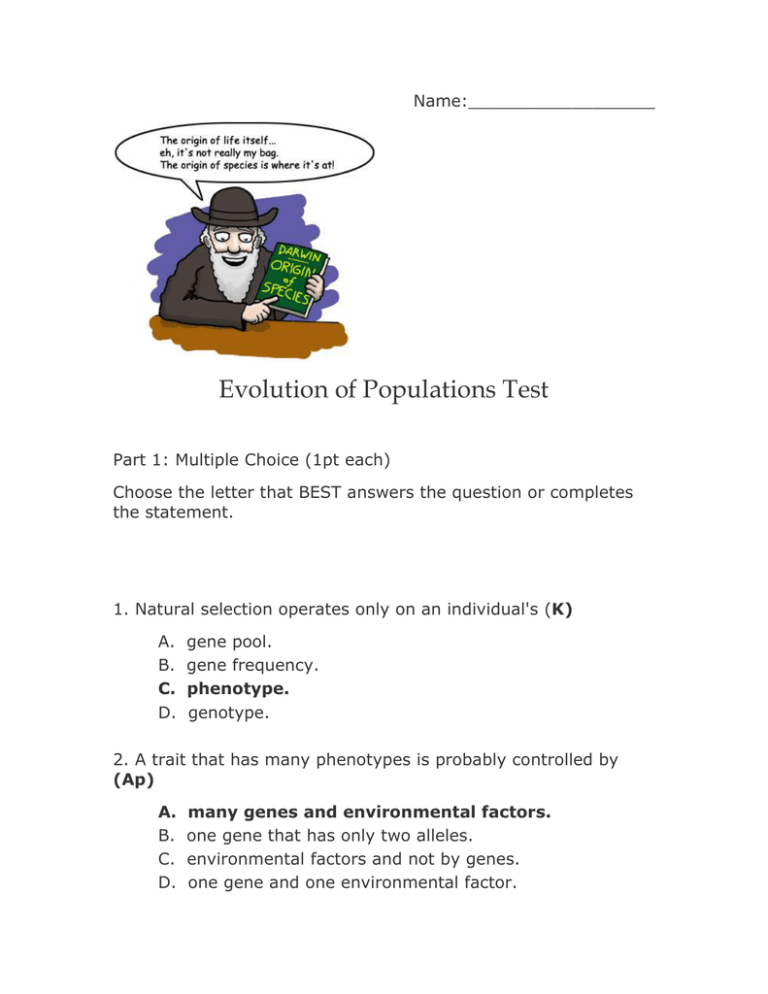
Name:__________________
Evolution of Populations Test
Part 1: Multiple Choice (1pt each)
Choose the letter that BEST answers the question or completes
the statement.
1. Natural selection operates only on an individual's (K)
A.
B.
C.
D.
gene pool.
gene frequency.
phenotype.
genotype.
2. A trait that has many phenotypes is probably controlled by
(Ap)
A.
B.
C.
D.
many genes and environmental factors.
one gene that has only two alleles.
environmental factors and not by genes.
one gene and one environmental factor.
3. Among the finch populations of the Galápagos Islands, the
founder effect, reproductive isolation, and competition all
contributed to (K)
A.
B.
C.
D.
speciation.
genetic equilibrium.
stabilizing selection.
genetic drift.
4. Speciation cannot take place without(Ap)
A.
B.
C.
D.
homologous structures.
disruptive selection.
geographic isolation.
reproductive isolation.
5. A population that satisfies the conditions of the HardyWeinberg principle will experience(Ap)
A.
B.
C.
D.
directional selection.
stabilizing selection.
a founder effect.
no natural selection.
6. The likely effect of natural selection on a single-gene trait
is(Ap)
A. selection by genetic drift.
B. genetic equilibrium.
C. reproductive isolation.
D. a change in allele frequencies.
7. Genetic drift is most likely to occur in populations that are(K)
A.
B.
C.
D.
at genetic equilibrium.
experiencing directional selection.
small in size.
large in size.
8. Most genetic variation is due to(K)
A.
B.
C.
D.
mutation and natural selection.
mutation and genetic shuffling.
artificial selection and natural selection.
founder effects and sexual recombination.
9. Which of the following is LEAST likely to affect genetic
equilibrium? (Ap)
A.
B.
C.
D.
migration
selective mating
population size
mutation
10. A change in climate that makes the environment drier is
likely to result in(Ap)
A. disruptive selection.
B. directional selection.
C. artificial selection.
D. stabilizing selection.
Part 2. Short Answer
For questions 11, 12, & 13: Read the Graph and 1) Identify what
type of selection is taking place, and 2) Give an example of how
this may occur in nature. (3 pts each)
11.
Type of selection:__stabilizing_________(Ap) ________
Example:_ (An) Given a fish population with variation in tail
size, both the small-tailed fish and the large-tailed fish are
selected against. The large-tailed fish are caught by predators,
and the small-tailed fish are not chosen as mates. This results in
a relative increase of medium-tailed fish.
12.
Type of selection:__directional__(Ap) ________
Example:__ (An) _In the previously mentioned fish population,
the females do not select mates based on tail size. In this
instance, the predators catching the large-tailed fish would lead
to a general decrease in tail size for the entire population.
13.
Type of selection:___disruptive_______(Ap) _
Example:__ (An) I’ll use the same fish population as an
example. In this instance, large-tailed fish intimidate predators,
and do not get eaten, and small-tailed fish succeed in hiding from
predators. This leads to higher predation on medium-tailed fish,
and relative increases in numbers of both large and small-tailed
fish.
Answer the following in complete sentences. (4 pts each)
14. What is reproductive isolation? How is it related to
speciation? (Ap)
Reproductive isolation means two populations cannot interbreed
and produce fertile offspring. This is a prerequisite for
speciation.___________________________________________
____________________________________________________
15. What is Genetic Drift? In what kinds of situations is it likely
to occur? (K)
Genetic Drift is a random change in allele frequency usually
associated with very small population size. Genetic drift may
occur when a small population colonizes a new habitat.
16. What two testable assumptions were the bases for Darwin’s
hypothesis about the evolution of the Galapagos finches? (K)
1. There was significant, heritable variation in the beak sizes and
shapes of the Galapagos finches.
2. Those differences produced differences in fitness, on which,
natural selection could act.
17. Explain how the Galapagos finches may have evolved. (Ap)
Speciation in the Galapagos finches occurred by founding of a
new population, geographic isolation, changes in the new
population gene pool, reproductive isolation, and ecological
competition.
Key for Question Types:
(K) - knowledge/ comprehension
(Ap) - Application
(An) - Analysis
(S) - Synthesis/ evaluation
Work Cited:
Miller, K. & Levine, J. (2006). Prentice Hall Biology. New York: Pearson
Prentice Hall.

